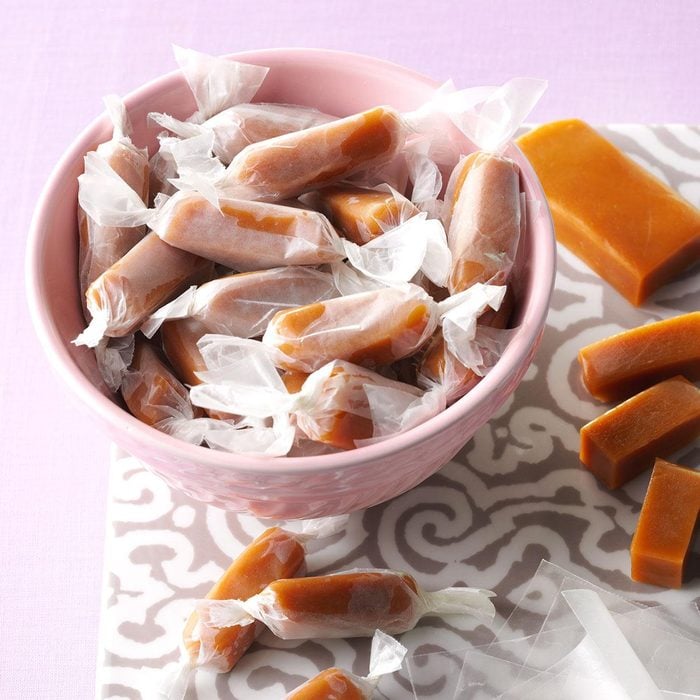Orange Cheesecake Breakfast Rolls
These yummy rolls are a nice change of pace from the typical brown sugar and cinnamon kind. They make a nice treat for breakfast or brunch. —Hannah Cobb, Owings Mills, Maryland
Go to Recipe
Orange Cranberry BreadThis orange cranberry bread is packed with the zesty taste of cranberries and orange peel. I suggest serving slices toasted with butter or cream cheese. —Ron Gardner, Grand Haven, Michigan
Fennel Orange SaladYou'll need just a few ingredients to fix this fresh-tasting fennel orange salad. The combination of crisp fennel and juicy oranges is delightful. To reduce last-minute prep, make it the day before you plan to serve it. —Nina Hall, Spokane, Washington
Croissant Breakfast CasseroleTurning croissants and marmalade into a classic overnight croissant breakfast casserole makes a wonderful treat for family and guests around the breakfast table. —Joan Hallford, North Richland Hills, Texas
Orange Spritz CookiesBrown sugar gives these spritz cookies a lovely light caramel tint. This variation has a rich buttery shortbread taste and texture with a hint of orange flavor. They are a delightful addition to my holiday cookie tray. —Sean Fleming, St. Charles, Illinois
Cranberry Orange Walnut BreadComing from Oregon, a state famous for its cranberries, this bread is a given at our house. Each fall my husband and I scrounge around for walnuts to go in it. It's a regular on our table, and not just at Thanksgiving. I freeze the berries so I have a ready supply all year long. —Elaine Kremenak, Grants Pass, Oregon
Orange Ricotta PancakesThese popular pancakes are likely to spark a craving. For a different twist, switch the citrus ingredient to lime or lemon juice. —Brehan Kohl, Anchorage, Alaska
Orange-Glazed Pork LoinThis is one of the best pork recipes I've ever tried. My family looks forward to this roast for
dinner, and guests always want the recipe. The flavorful rub, and the glaze brightened with
orange juice, are also outstanding on pork chops. —Lynnette Miete, Alna, Maine
Pineapple Orange CakeThis is one of my favorite cakes. It’s moist and light yet so satisfying. I’ve been adapting it for years and now it’s almost guilt-free. —Pam Sjolund, Columbia, South Carolina
Orange-Glazed Pork with Sweet PotatoesWhen it's chilly outside, I like to roast pork tenderloin with sweet potatoes, apples and an orange. The sweetness and spices make any evening cozy. —Danielle Boyles, Sparta, Wisconsin
Creamy Orange CaramelsEach Christmas I teach myself a new candy recipe. Last year I started with my caramel recipe and added a splash of orange extract for fun. This year I just might try buttered rum extract. —Shelly Bevington-Fisher, Hermiston, Oregon
Tilapia with Citrus SauceThe lemon, lime and orange sauce adds zest to this flaky, delicate-flavored fish. —Francis Garland, Anniston, Alabama
Cranberry Orange SconesMoist and scrumptious, these scones come out perfect every time. I savor the chewy dried cranberries and sweet orange glaze. There's nothing better than serving these remarkable scones warm with the delicate orange butter. —Karen McBride, Indianapolis, Indiana
Lemon Orange CakeI like to bake this lovely three-layer lemon and orange cake instead of a more traditional pie for Thanksgiving. It has that tangy Florida citrus flavor and isn't any more difficult to make than a two-layer cake. —Norma Poole, Auburndale, Florida
Orange Buttermilk CupcakesSimple and delicious, this is our all-time favorite low-fat dessert. You'll be surprised how well the citrus flavor comes through in every bite. —Kim Chester, Cartersville, Georgia
Crispy Orange ChickenWe enjoy these tangy nuggets so many ways—over noodles or rice, in sandwiches, even on top of lettuce and cabbage. —Darlene Brenden, Salem, Oregon
Orange AppealOranges add color and great taste to winter meals! This dish looks very bright and appealing served in a glass bowl, and it's a light and easy dessert to finish off a hearty holiday meal. As far as I'm concerned, the citrusy aroma of oranges is a must at Christmas time! —Billie Moss, Walnut Creek, California
Jazzy GelatinFinish things off with a bang with this colorful gelatin garnished with fresh grapes. Chock-full of mandarin oranges and crushed pineapple, it's so refreshing that guests won't be able to refrain from seconds. —
Taste of Home Test Kitchen, Milwaukee, Wisconsin
Pork Chops with GlazeRosemary adds a special touch to these beautifully glazed pork chops that are just right for any meal. —Louise Gilbert, Quesnel, British Columbia
Chilled Fruit CupsThis refreshing frozen salad is easy to assemble ahead and serve to a group at breakfast—or any time of day. It's a convenient and colorful addition to a holiday buffet. —Andrea Hawthorne, Mozeman, Montana
Salmon with Mango-Citrus SalsaMy mother would make this for us on weeknights in summer—this was the only way we would eat fish. You can make the salsa a day ahead of time. Just keep it in the refrigerator in a covered container until ready to use. —Najmussahar Ahmed, Canton, Michigan
Cranberry Orange PancakesAs special as the holidays, these fluffy pancakes are drop-dead gorgeous, ready in just minutes and brimming with sweet, tart and tangy flavor. Seconds, anyone? —Nancy Zimmerman, Cape May Court House, New Jersey
Curried Pork & Orange KabobsI love the sweet flavor of red, yellow and orange peppers. I always go for these in the summer when they are inexpensive and plentiful. I think they taste a whole lot better than green peppers. —Liv Vors, Peterborough, Ontario
Arctic Orange PieThis frosty orange pie is so easy to make. I have tried lemonade, mango and pineapple juice concentrates instead of orange, and my family loves each one. —Marie Przepierski, Erie, Pennsylvania
Orange LemonadeThis juice is a favorite at our place. I'll often double the batch and send a jar next door to my mother-in-law! I was looking for a way to sweeten lemonade without using more sugar when I came up with the recipe. —Wendy Masters, Grand Valley, Ontario
Cran-Orange Icebox CookiesThese are among my family's favorite cookies around Christmas. The cran-orange flavor makes them special. —Nancy Rollag, Kewaskum, Wisconsin
Citrus ScallopsMy husband and I like to eat seafood at least once a week. Oranges and lemon juice give scallops a refreshing burst of flavor. —Cheri Hawthorne, North Canton, Ohio
Double Orange CookiesI serve these nutritious, tasty cookies to my husband and our four children. Also, because my husband is a minister, I often cook for guests in our home. —Pamela Kinney, Irving, Texas
White Chocolate Brie CupsTry these unique little tarts as an appetizer before a special meal, or save them for a surprisingly different dinner finale. They’re sweet, creamy and crunchy—and very addictive! —Angela Vitale, Delaware, Ohio
Happy Orange TurkeyHere’s the perfect centerpiece for your Thanksgiving feast. Champagne and oranges flavor this special bird that will become one of your favorite turkey recipes ever. —Tara Baier, Menomonie, Wisconsin
Orange & Lemon Wafer CookiesThese light citrus cookies go so well with a cup of coffee or tea after a heavy holiday meal. —JoAnn Belack, Bradenton, Florida
Grandmother's Orange SaladThis orange salad dessert is slightly sweet and tangy, too. It adds beautiful color to any meal and appeals to all ages! —Ann Eastman, Santa Monica, California
Orange Dream Mini CupcakesThe bright taste of these cute cupcakes reminds me and my friends of orange-and-vanilla frozen treats. —Jen Shepherd, St. Peters, Missouri
Rustic Cranberry & Orange BreadStudded with cranberries, slices of pretty bread make the perfect holiday brunch treat. —Megumi Garcia, Milwaukee, Wisconsin
Citrus Steak SaladYour family will think you spent hours on this beautiful main dish salad with its from-scratch dressing, but it's an absolute cinch! —
Taste of Home Test Kitchen
Macadamia Sunshine BarsYour guests will be delighted with my bars. They are packed with nuts and dried fruit. I think that when you take a bite of this treat it’s like a mini-vacation to a Polynesian paradise. —Jeanne Holt, Mendota Heights, Minnesota
Orange Dream Angel Food CakeA basic angel food cake becomes a heavenly indulgence, thanks to a hint of orange flavor swirled into every bite. The orange color makes slices of the cake look so pretty when arranged on individual dessert plates. —Lauren Osborne, Holtwood, Pennsylvania
Orange Jelly CandiesMaking candy is my favorite thing to do. I've been collecting candy recipes for more than 40 years and have taken several candy-making classes. These soft confections are fantastic. —Leah Jackson, Washington, Utah
Orange-Glazed HamThis delicious ham looked like a sparkling jewel on the table when my mom served it for Easter dinner. The flavor of the spice rub penetrates through every tender slice. Even its enticing aroma while baking can't match the wonderful taste. —Ruth Seitz, Columbus Junction, Iowa
Triple Citrus SconesI love the bright and buttery flavor of these tender scones with glaze that soaks in. Serve them with a yummy jam, or try them as a base for strawberry shortcake. —Angela LeMoine, Howell, New Jersey
Orange JellyFor a change of pace, give this yummy jelly made from frozen orange juice a try. I've given it as gifts to friends and family—and many times the jars have been returned for refills. —Mary Rice, Maysville, Oklahoma
Beef Orange Stir-FryThis dinner for two is loaded with lots of flavor and color. Red pepper flakes add a little kick to the orange beef sauce, and the tender veggies add a pop of color. —
Taste of Home Test Kitchen
Glazed Ginger BarsI can’t think of the holidays without these luscious bars. The scent and flavor of ginger are just right for the season, and the light glaze adds the perfect amount of sweetness. —Darlene Brenden, Salem, Oregon
Glazed Cornish HensIf you're looking to add a touch of elegance to your holiday dinner table, our Test Kitchen experts suggest these Cornish game hens topped with a sweet apricot glaze. —
Taste of Home Test Kitchen, Milwaukee, Wisconsin
Sparkling OrangesWe were living in Texas when I found the recipe for this simple yet elegant salad. I was thrilled—we had a surplus of fresh oranges! All you do at the last minute is garnish and serve. —Janie Bush, Weskan, Kansas
Orange Soda SherbetFor birthdays, we pull out the old-fashioned ice cream maker and crank out a sherbet made with orange soda. We're all crazy about it, especially my son. —Heather Craft, Paducah, Kentucky
Citrus-Marinated ChickenThis juicy, zesty chicken stars in many of my family’s summer meals. While there are a million ways to dress up poultry, you’ll find yourself turning to this recipe again and again. It’s that quick and easy! —Deborah Gretzinger, Green Bay, Wisconsin
Elegant Orange Blossom CheesecakeThe aroma of orange zest hints at how heavenly this delicate cheesecake tastes. Gingersnap cookie crumbs make a distinctive crust, while glazed orange slices become a blossomlike topping. —Sharon Delaney-Chronis, South Milwaukee, Wisconsin
Cranberry Orange Sandwich CookiesMy sweet-tart cookies make a terrific addition to a holiday dessert tray. I love the creamy orange filling. —Trisha Kruse, Eagle, Idaho
Chipotle-Orange BaklavaCitrus, cinnamon and smoky chipotle peppers make my version of this flaky, sweet pastry so unique. It's really rich, so a little goes a long way. —Christine Neary, Portland, Oregon
Frozen Citrus Fruit CupsAdd some sparkle to your next get-together or church supper with these sunny citrus treats. The refreshing cups burst with color and flavor, plus they look so cute served in shiny foil containers. —Sue Ross, Casa Grande, Arizona
Orange Dream MimosasYour inner child will love this fun riff on the classic mimosa. Use sparkling cider, ginger ale or sparkling grape juice for a nonalcoholic version. —Deirdre Cox, Kansas City, Missouri
Orange Natilla Custard PieAfter tasting
natilla for the first time at a Cuban restaurant in Key West, I knew I had to turn that traditional custard into a pie. For a festive garnish, add curls of orange zest. —Amy Freeze, Avon Park, Florida
Orange TwistsThese soft and sweet twists have a long shelf life. You can make a number of flavor variations with this recipe, including lemon, cherry and almond. I sometimes add a confectioners' sugar glaze. —Raine Gottess, Lantana, Florida
Cranberry-Filled Orange Pound CakeI made this for a holiday dinner with my family. Everyone loved the cran-orange flavor and the sweet glaze drizzled on top. For a fun variation, include 2/3 cup flaked sweetened coconut when adding the orange juice to the batter, and sprinkle the finished cake with toasted coconut. —Patricia Harmon, Baden, Pennsylvania
Orange Juice SpritzerHere’s a zippy twist on regular orange juice. It is not too sweet and is refreshing with any breakfast or brunch entree. —Michelle Krzmarzick, Torrance, California
Orange Breakfast Souffle with Dried CherriesOur family often took this decadent breakfast souffle to a local park on Father's Day. It's easy to make the night before, pop in the oven the next morning and go! —Sharon Ricci, Mendon, New York
Budapest RollIf you’re a fan of Yule logs and pumpkin rolls, taste my Swedish specialty made from hazelnut meringue. People are in awe every time I bring it somewhere. —Catherine Walbridge, Boise, Idaho
Cinnamon-Orange Honey ButterThis is such a delicious butter spread for afternoon tea or with a dessert bread. Just mix it up and get ready for the compliments. —Mary Bates, Cleveland, Ohio
Orange-Fig Pull-ApartsFor breakfast on Thanksgiving, my mom requested an orange pull-apart bread. I tried making one by dressing up tubes of refrigerated rolls. She loved it! —Shelly Bevington, Hermiston, Oregon
Orange-Cranberry Nut TartsMy friend gave me a recipe for orange cookies. I just had to embellish it. Now my friends and family crave these tarts. —Nancy Bruce, Big Timber, Montana
Orange Pistachio CookiesI had never tried pistachios until I visited a friend who served me these cookies. I was in love! I made the recipe my own, and now my family can't get enough of them. —Lorraine Caland, Shuniah, Ontario
Marmalade Candied CarrotsMy favorite way to make baby carrots is to steam them, then drizzle with an orangey glaze that makes them candy-sweet. —Heather Clemmons, Supply, North Carolina
Coconut Citrus Layer CakeMake a showstopper holiday treat: tender white cake layered with tangy grapefruit curd and topped with fluffy cream cheese frosting. To make it more spectacular add a little toasted coconut and some citrus garnishes. Your guests will never guess you started with a convenient boxed mix. —Carmell Childs, Ferron, UT
Powerhouse Protein ParfaitsParfaits have marvelous taste and texture, but many are loaded with sugar and leave you peckish for more. Here’s my protein-inspired option with yogurt, fruit and nuts. —Jen Hubin, Minnetonka, Minnestoa
Orange Poppy Seed CookiesMy friend Sandy and I have gotten together for years to bake Christmas cookies. One year we made 16 different kinds in a day. I like this cookie because the orange flavor makes a nice change of pace from all the classic holiday cookies. —Kathy Jessen, Sarasota, Florida
Fruit & Spinach SaladThe combination of sweet fruit and salty feta cheese makes this salad a winner. —Virginia Dack, Asheville, North Carolina
Orange TeaMy children always appreciated a hot cup of this beverage after walking home from school. The tea is refreshing and tasty, and it warms you up. For about half the year, warmth is something we can always use more of around here! —Sally Mueller, Loveland, Colorado
Orange-Almond ChoclavaA twist on classic baklava, this recipe adds semisweet chocolate to the nut filling and drizzles even more chocolate on top. Christmas gift-giving has never been yummier! —Nella Parker, Hersey, Michigan
White Chocolate Cranberry-Orange BarsThis is my take on my mother's recipe for chocolate chunk bars, which she made every Christmas Eve. Our family is scattered across the country now; making these reminds me of home. If you don't have a pastry cutter, you can use two sharp knifes or a potato masher. My mom makes this with semisweet chocolate chunks. —Erin Powell, Amarillo, Texas
Vanilla Citrus CiderMy mom used to make cider for the holidays, so I based my citrus-vanilla variation on her recipe. I think it hits the spot! The longer the cider simmers, the stronger the flavors will be. —Kristin Weglarz, Bremerton, Washington
Orange Sugar CookiesI make these citrusy cookies for parties and special occasions, and we always get to eat the ones that don't come out perfectly. Eventually I had to start making extra "mistakes" to keep my family happy! —Myrrh Wertz, Milwaukee, Wisconsin









































































